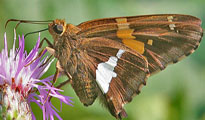Native Plants
Search for native plants by scientific name, common name or family. If you are not sure what you are looking for, try the Combination Search or our Recommended Species lists.
Glycyrrhiza lepidota
Glycyrrhiza lepidota Pursh
American Licorice, Wild Licorice
Fabaceae (Pea Family)
Synonym(s): Glycyrrhiza glutinosa, Glycyrrhiza lepidota var. glutinosa
USDA Symbol: GLLE3
USDA Native Status: L48 (N), CAN (N)
Erect perennial up to 4 ft. The stem is covered with minute, sticky hairs. Cream flowers, which resemble those of alfalfa, are crowded on a terminal spike. Leaves are pinnately compound. The brown fruit is covered with hooked spines and resembles a cocklebur.
The root has a distinct licorice flavor, but commercial licorice is obtained from another plant of this genus that is not a North American native.
Plant Characteristics
Duration: PerennialHabit: Herb
Leaf Arrangement: Alternate
Fruit Type: Legume
Size Notes: Up to about 4 feet tall.
Leaf: Green
Bloom Information
Bloom Color: WhiteBloom Time: Jun , Jul , Aug , Sep
Bloom Notes: Sometimes tinged with pale pink or purple.
Distribution
USA: AR , AZ , CA , CO , CT , IA , ID , IL , IN , KS , MA , ME , MN , MO , MT , ND , NE , NM , NV , NY , OK , OR , PA , RI , SD , TX , UT , VA , WA , WI , WYCanada: AB , MB , SK
Native Distribution: W. Ont. to B.C., s. to n.w. MO, n. AR, TX, Mex. & CA
Native Habitat: Prairies; stream valleys; roadsides
Growing Conditions
Water Use: HighLight Requirement: Part Shade , Shade
Soil Moisture: Moist
CaCO3 Tolerance: Medium
Soil Description: Variable; often in heavy clay or saline soils.
Benefit
Use Wildlife: Deer and pronghorn eat the foliage. Upland game birds and small mammals eat the seeds. Pocket gophers eat the rhizomes.Use Medicinal: Tea of peeled dried roots or leaves used for diarrhea and upset stomach. Root chewed and held in mouth for toothache. Tea made of roots used for coughs, chest pain and sore throat. (Kindscher) Root boiled in water to make tea drunk to speed delivery of placenta. Leaves steeped in water used for earache. (Weiner)
Conspicuous Flowers: yes
Attracts: Butterflies
Larval Host: Silver-spotted Skipper (Epargyreus clarus)
Value to Beneficial Insects
Special Value to Native BeesSupports Conservation Biological Control
This information was provided by the Pollinator Program at The Xerces Society for Invertebrate Conservation.
Butterflies and Moths of North America (BAMONA)
|
Silver-spotted Skipper (Epargyreus clarus)  Larval Host |
Propagation
Description: Seeds germinate but the rate is somewhat low and decreases with treatment. Rhizome cuttings can be taken in spring or fall. Stem cuttings require intermittent mist.Seed Treatment: Do not pretreat.
Commercially Avail: yes
Find Seed or Plants
Find seed sources for this species at the Native Seed Network.
National Wetland Indicator Status
| Region: | AGCP | AK | AW | CB | EMP | GP | HI | MW | NCNE | WMVE |
| Status: | FACU | FAC | UPL | FACU | FACU | FACU | FAC |
From the National Organizations Directory
According to the species list provided by Affiliate Organizations, this plant is on display at the following locations:Native Seed Network - Corvallis, OR
Bibliography
Bibref 1207 - Earth Medicine, Earth Food (1990) Michael A. WeinerBibref 610 - Edible wild plants of the prairie : an ethnobotanical guide (1987) Kindscher, K.
Bibref 1186 - Field Guide to Moths of Eastern North America (2005) Covell, C.V., Jr.
Bibref 1185 - Field Guide to Western Butterflies (Peterson Field Guides) (1999) Opler, P.A. and A.B. Wright
Bibref 946 - Gardening with Prairie Plants: How to Create Beautiful Native Landscapes (2002) Wasowski, Sally
Search More Titles in Bibliography
Web Reference
Webref 23 - Southwest Environmental Information Network (2009) SEINet - Arizona ChapterAdditional resources
USDA: Find Glycyrrhiza lepidota in USDA PlantsFNA: Find Glycyrrhiza lepidota in the Flora of North America (if available)
Google: Search Google for Glycyrrhiza lepidota
Metadata
Record Modified: 2023-02-13Research By: TWC Staff